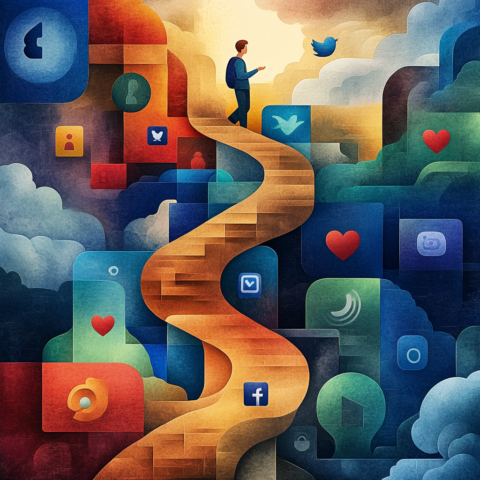 In the labyrinth of ones and zeros, a new species emerges. They’re not digital immigrants like us, fumbling with user manuals and blinking cursor. No, they’re the first true digital natives, and they’re rewriting the rules of engagement with information.
In the labyrinth of ones and zeros, a new species emerges. They’re not digital immigrants like us, fumbling with user manuals and blinking cursor. No, they’re the first true digital natives, and they’re rewriting the rules of engagement with information.
Let’s set the scene: A teenager sprawls across a beanbag, fingers dancing across screens, earbuds nestled in place. To the uninitiated, it looks like chaos. But there’s a method to this madness, a new language of information consumption that we’re only beginning to decipher.
This isn’t about shorter attention spans or the death knell of long-form content. It’s a fundamental shift in how knowledge is acquired, trust is built, and reality is constructed. We’re witnessing the birth of a new epistemology, forged in the crucible of the digital age.
The Trust Tango
Imagine a world where credibility is as fluid as mercury, where authority is earned in likes and shares rather than years of study. Welcome to Gen Z’s reality.
In this brave new world, traditional gatekeepers find themselves shouting into the void, their voices lost in a cacophony of influencers, peer reviews, and viral content. It’s not that Gen Z doesn’t value expertise – they just define it differently.
Consider this: A 19-year-old is more likely to trust a YouTube tutorial on changing a tire than the car manufacturer’s manual. Why? Because the YouTuber speaks their language, acknowledges potential pitfalls, and most importantly, feels real.
This shift has profound implications. On one hand, it democratizes information, giving voice to perspectives often sidelined by traditional media. On the other, it creates fertile ground for misinformation, where emotional resonance can trump factual accuracy.
- 68% of Gen Z consult social media before making major decisions
- Only 41% trust traditional news outlets as primary sources
- 82% value peer reviews over expert opinions when choosing products
These aren’t just statistics; they’re signposts pointing towards a seismic shift in how information is valued and verified.
The Authenticity Paradox
“Just be yourself,” the adage goes. For Gen Z, it’s not just advice – it’s the gold standard of credibility. In a world awash with polished corporate messaging and airbrushed realities, rawness has become the new sophistication.
This hunger for authenticity is reshaping how information is packaged and presented. The stoic newscaster is out; the passionate, opinionated content creator is in. It’s why a shaky smartphone video of a protest can feel more “true” than a polished news report.
But here’s where it gets tricky: Authenticity, powerful as it is, isn’t synonymous with accuracy. The most genuine-seeming source can still be woefully misinformed or intentionally deceptive. It’s a paradox Gen Z is grappling with in real-time: How do you discern truth in a world where everyone seems to have their own version of it?
The Crowdsourced Truth
Remember when fact-checking meant dusting off an encyclopedia? For Gen Z, truth is a collaborative effort, a living document constantly updated by the wisdom (or folly) of the crowd.
When presented with new information, the Gen Z response isn’t to consult an authoritative source, but to gauge the collective response. It’s a fascinating shift from vertical to horizontal fact-checking. Instead of relying on a single authoritative source, Gen Z triangulates truth through multiple perspectives.
It’s messy, it’s chaotic, but it’s also incredibly resilient to manipulation. After all, it’s much harder to fool a crowd than a single gatekeeper. But this approach isn’t without its pitfalls. Echo chambers are real, and algorithms designed to maximize engagement often reinforce existing beliefs rather than challenge them.
The challenge for Gen Z (and for all of us) is to cultivate diverse information ecosystems that expose us to a range of perspectives. It’s not enough to be connected; we need to be correctly connected.
 The Comfort Trap
The Comfort Trap
Here’s a thorny question: Is it better to be comfortable or correct? For many in Gen Z, comfort often wins out. There’s a growing tendency to curate one’s information diet, filtering out anything that might cause discomfort or challenge deeply held beliefs.
On the surface, this seems like self-care. After all, why subject yourself to distressing information if you don’t have to? But dig deeper, and we find a troubling trend. By avoiding discomfort, we risk creating echo chambers that reinforce our biases and limit our growth.
This avoidance of discomfort isn’t unique to Gen Z, but it’s amplified by the personalized nature of digital media. Algorithms, designed to keep us engaged, serve us more of what we like and less of what challenges us. It’s a comfortable bubble, but one that can lead to a narrowing of perspectives and an inability to engage with differing viewpoints.
The challenge, then, is to find ways to make discomfort valuable. To reframe challenging information not as a threat, but as an opportunity for growth. It’s a skill that will be crucial not just for Gen Z, but for all of us navigating an increasingly polarized world.
The New Media Literacy
In this brave new world of information consumption, media literacy isn’t just a nice-to-have—it’s survival gear. But what does media literacy look like when the media landscape is constantly shifting?
For Gen Z, it’s less about identifying reliable sources (a nearly impossible task in the age of deepfakes and AI-generated content) and more about developing a set of critical thinking skills that can be applied universally. It’s about asking questions like:
- Who benefits from this information?
- What’s the broader context?
- How does this align with or challenge my existing beliefs?
- What are the potential biases at play?
These aren’t new questions, but their importance has never been greater. As the lines between entertainment, advertising, and information continue to blur, the ability to navigate this complex landscape becomes a crucial life skill.
The Crystal Ball Conundrum
So, where does all this lead? As Gen Z matures and takes the reins of society, how will their unique relationship with information shape our world?
One possibility is a further fragmentation of shared reality. As personalized media bubbles become more entrenched, finding common ground on even basic facts could become increasingly challenging. We might see the rise of “reality spheres”—communities united not by geography or ideology, but by shared information ecosystems.
On the flip side, Gen Z’s skepticism and media savvy could lead to a renaissance of critical thinking. We might see a renewed emphasis on media literacy in education, and the development of new tools to help navigate the information landscape.
The role of traditional institutions—governments, universities, media outlets—will likely continue to evolve. Rather than being primary sources of information, they may become curators and contextualizers, helping to make sense of the information deluge.
One thing is certain: The way Gen Z consumes and processes information will have profound implications for everything from politics to marketing to education. Understanding this shift isn’t just academic curiosity—it’s essential for anyone hoping to communicate effectively in the coming decades.
In the end, perhaps the most valuable skill we can cultivate, regardless of generation, is adaptability. The information landscape will continue to evolve, and our ability to navigate it will depend on our willingness to learn, unlearn, and relearn.
As we stand at this inflection point in human history, watching the first true digital natives come of age, we’re witnesses to a grand experiment. Gen Z isn’t just consuming information differently—they’re redefining what information means in a connected world. And in doing so, they’re shaping the future of knowledge itself.
It’s a future that’s uncertain, challenging, and endlessly fascinating. Just like Gen Z themselves.



